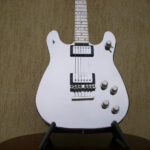The C7 chord, a vibrant variation of the standard C major, injects a unique, bluesy flavor into your guitar playing. Often described as having a “quavering brightness,” this dominant seventh chord adds depth and complexity, capable of creating moods ranging from introspective and questioning to hopeful and resolved within a song.
Ready to explore the sonic possibilities of the C7 chord? Let’s dive in and discover how to play it and where you can use it to enrich your music!
Grasping the C7 Guitar Chord: Three Essential Positions
The C7 chord distinguishes itself from a regular C major chord by the addition of a single note: the Bb, or flat seventh. This seemingly small alteration creates a significant shift in character, transforming the familiar major chord into a dominant seventh, packed with harmonic interest.
Seventh chords like the C7 are invaluable tools for guitarists. They offer a richer alternative when a basic major or minor chord feels too plain, or when you aim to introduce a touch of sophistication and color to your chord progressions. While substituting a C7 for a C major might not always be appropriate, experimenting with these variations is key to developing your musical ear and crafting your signature sound.
One of the most accessible ways to play the C7 chord is in its open position. This voicing utilizes five strings and delivers a full, resonant sound that’s perfect for beginners and seasoned players alike.
To form the open C7, begin by placing your index finger on the 1st fret of the B string (2nd string). Then, use your middle finger to fret the D string (4th string) at the 2nd fret. Finally, position your ring finger on the A string (5th string) and your pinky finger on the G string (3rd string), both at the 3rd fret. Avoid strumming the low E string, and strum downwards from the A string.
C7 Chord Open Position Finger Placement:
- Middle finger: 2nd fret of the D (4th) string
- Ring finger: 3rd fret of the A (5th) string
- Pinky finger: 3rd fret of the G (3rd) string
Strum 5 strings down from the A (5th) string, avoiding the low E string for a clear C7 sound.
While the open C7 position boasts a robust tone, exploring other variations up the fretboard opens up new sonic textures and voicings.
Moving up the neck, the 3rd position C7 chord offers a higher register and a slightly different tonal quality. Starting at the 3rd fret, this version utilizes only four strings, resulting in a brighter, more focused sound compared to the open position.
To play the 3rd position C7, place your index finger on the G string (3rd string) at the 3rd fret. Stretch your ring finger to reach the D string (4th string) at the 5th fret. Lastly, add your pinky finger to the B string (2nd string) at the 5th fret. Strum downwards from the D string.
C7 Chord 3rd Position Finger Placement:
- Index finger: 3rd fret of the G (3rd) string
- Ring finger: 5th fret of the D (4th) string
- Pinky finger: 5th fret of the B (2nd) string
Strum 3 strings down from the D (4th) string for this higher-pitched C7 voicing.
For a more advanced and even higher-pitched C7, venture further up the fretboard to the 8th position. This variation, located higher on the neck, demands a muting technique to achieve the desired sound.
To play the 8th position C7, begin with your index finger barring the low E string (6th string) at the 8th fret. Crucially, use the underside of your index finger to lightly mute the A string (5th string) – this is key to getting a clean C7 sound. Then, place your middle finger on the D string (4th string) at the 8th fret. Finally, add your ring finger to the G string (3rd string) at the 9th fret. Strum downwards from the low E string, omitting the B and high E strings, while ensuring the A string remains muted.
C7 Chord 8th Position Finger Placement:
- Index finger: 8th fret of the low E (6th) string (muting the A string)
- Middle finger: 8th fret of the D (4th) string
- Ring finger: 9th fret of the G (3rd) string
Strum four strings down from the low E string, carefully muting the A string to produce the distinct 8th position C7.
Deconstructing the C7 Chord: The Notes Within
As mentioned earlier, the C7 chord is essentially a C major chord with an added note – the flat seventh, Bb.
Specifically, the C7 chord is built from four notes:
- C (Root)
- E (Major Third)
- G (Perfect Fifth)
- Bb (Minor Seventh)
This Bb note is what imparts the C7 chord its characteristic “dominant” quality. It’s this flatted seventh that introduces a sense of tension and anticipation, distinguishing the C7 from the brighter, more stable sound of a plain C major chord. This inherent tension is what makes the C7 so effective in creating dynamic and emotionally resonant music.
C7 Chord in Action: Songs Across Genres
The C7 chord’s versatility makes it a favorite among songwriters across diverse musical styles. From rock anthems to soulful blues and catchy pop tunes, the C7 adds its unique flavor to countless songs. Here are just a few examples of how the C7 chord is used in popular music:
Rock Anthems and C7 Chords
The Beatles, masters of innovative chord arrangements, incorporated a lively C7 chord into their early hit, “From Me to You.” Guitarist George Harrison’s jangly C7 contributes to the song’s upbeat and memorable character. The Beatles frequently utilized the C7, and you can also hear it in tracks like “Taxman,” “If You Believe,” and “Something,” showcasing its adaptability within rock arrangements.
Pop Sensibilities and the C7
The slightly melancholic yet intriguing nature of the C7 chord finds its place in pop classics like “Baby Love” by The Supremes and “All By Myself” by Eric Carmen. In “Baby Love,” the C7 adds a touch of yearning and uncertainty, mirroring the song’s theme of unrequited affection. In “All By Myself,” the C7’s inherent loneliness reinforces the song’s emotional core.
However, the C7 isn’t always about introspection. Its cheerful side shines through in “Bare Necessities,” the beloved Disney tune from The Jungle Book. Dominant 7th chords like G7, A7, E7, and D7, including the C7, drive the song’s optimistic and carefree spirit, demonstrating the chord’s versatility in creating uplifting moods.
“When the Saints Go Marching In,” a timeless classic bridging gospel, pop, and jazz, heavily features the C7. Evoking the spirit of New Orleans, the C7 provides the song’s signature punch and energy. Incorporating bass note strumming with the C7 chord further enriches the song’s rhythm and makes it a rewarding challenge for guitarists.
Bluesy Expressions with the C7 Chord
The inherent tension and release within the C7 chord make it a natural fit for the blues genre. Rev. Gary Davis masterfully employs the C7 in his “Hesitation Blues,” while Buddy Guy, in “Let Me Love You Baby,” utilizes the chord to express both longing and assertiveness in his romantic plea. Buddy Guy’s iconic blues track, featuring the C7, has been covered by guitar legends like Stevie Ray Vaughan and Jeff Beck, solidifying its place in blues history.
Country Roads and C7 Harmonies
The C7 chord’s adaptability extends into country music, where it’s used by genre-defining artists in some of their most enduring hits.
Hank Williams, a foundational figure in country music, incorporated the C7 into his classic, “Hey Good Lookin’.” Alongside other 7th chords (G7 and D7), as well as C and F major chords, the C7 contributes to the definitive sound of this country standard, covered countless times.
Conway Twitty, another country icon, used the C7 in his poignant ballad, “Hello Darlin’,” to create a subtle unease that underscores the bittersweet reunion with a former love. “Hello Darlin’,” with its effective use of the C7, became a signature song for Twitty and a concert opener for years.
Eager to make the C7 a staple in your guitar vocabulary? Ready to expand your chord knowledge further? Explore Fender Play’s extensive chord library to learn about various chord types and discover tips for mastering them.
If you’re not yet a member, sign up for a free trial and unlock a world of guitar learning!
Loading…


